1/48 Zvezda Bf-109F-4
Some claim the kit is "fiddly," but if you take care and follow the instructions, you won't use any seam filler. It's the most accurate Bf-109F in 1/48. Lifelike Decals 48-035 "Marseille Special" used, with Eduard seat belts.
The Star of Africa - Hans Joachim Marseille:
Hans Joachim Marseille is considered the most amazing, unique, and lethal ace of the Second World War. His score of 158 victories, all achieved against the RAF, is unmatched by any other Luftwaffe pilot. With an average lethality ratio of just 15 shots per victory. Marseille was described by Adolf Galland thus: "He was the unrivaled virtuoso among the fighter pilots of World War Two." As with many of the great German aces, his initial performance nearly resulted in his rejection from the Jagdwaffe.
Initially, Marseille was a non-conformist in an organization that did not accept such behavior, and his introduction to combat during the Battle of Britain was not a success, though on his third mission he shot down a Spitfire and by the end of the Battle Of Britain had seven victories; he was also shot down four times, while his behavior on the ground got him in trouble, since he had such busy night life that on occasion he was too tired to be allowed to fly the next morning. His love of American Jazz music was an additional strike against him. Following the Battle of Britain, he was returned to Germany, and there was serious thought given to getting rid of him. Fortunately, by the Spring of 1941, the Luftwaffe was stretched by its involvement in the Mediterranean and North Africa, and young Leutnant Marseille found himself "exiled" to North Africa with an assignment to I Gruppe, Jagdgeschwader 27, the Luftwaffe unit assigned to the Afrika Korps for air defense. There, the Geschwader Kommodore, Oberstleutnant Eduard "Edu" Neumann, gave Marseille the opportunity he needed.
With Neumann giving him the kind of support he needed, and with the lack of "social alternatives" in the desert, Marseille began to analyze his combat activity, and started a personal program to improve his abilities as a fighter pilot.
Marseille decided he would adapt his eyes to the powerful desert sun and dry desert atmosphere, and adapt his body to the desert conditions. He stopped wearing sun glasses, deliberately exposing his eyes to the desert sun, and replaced alcohol with milk. He discovered that in the intensely lit dry desert atmosphere an aircraft could be detected from greater distances than over Europe; from this he determined that ambush and surprise were less practical over the desert than in the cloudy European sky.
He also worked to strengthen his abdominal and leg muscles to enhance his ability to sustain higher G-Forces for longer durations during dogfights than the average fighter pilot. He took every opportunity to perform breathtaking aerobatics. In addition to providing entertainment to his friends, these exercises also gave him outstanding control and confidence in performing extreme maneuvers.
Finally, Marseille used his leftover ammunition to practice firing at ground objects; additionally, he became a master of high-deflection shooting while in a sharp turn, which is the most difficult gunnery situation to control.
Given the air combat conditions of North Africa, Marseille was able to fight alone with only a wingman. He claimed that when fighting alone in a short range dogfight, he could fire at anything he saw, while the pilots he attacked were confused, leading them to hesitate and switch to a defensive position that further increased the lone attacker's chances. His preferred method of attack was to make high-angle deflection shots from short range while in a sharp turn. He never used his gunsight, instead firing a very short burst at the passing target in the split second when its propeller disappeared behind his aircraft's nose. He calculated that with a short burst at this position at short range, the rounds would hit the target's engine and cockpit. He concluded that, over the desert, a fighter pilot can become "invisible" only by engaging in extreme maneuvers at close range, and that the intensity of the maneuvering was more important than speed.
Marseille first demonstrated his new abilities on Sept. 24, 1941. On a fighter sweep, he suddenly broke formation and flew off in a direction where no one else saw anything. When his fellow pilots caught up with him, he had already shot down a bomber. Later the same day, his formation of six met 16 Hurricanes. As a junior pilot, Marseille and his wingman were ordered to provide cover to the other four, which attacked the Hurricanes. After three Hurricanes were shot down, Marseille told his wingman to cover him and attacked a formation of four Hurricanes passing below. He dove, leveled at their altitude, and shot down two in a single burst while in a sharp turn. He then dove to gain airspeed then zoomed back up and shot down a third Hurricane. The two formations then disengaged. Marseille climbed to a higher altitude, then dove on retreating Hurricanes and shot down a fourth, his fifth victory of the day. On his return to base, he told a friend, "I believe now I have got it."
Marseille's most classic combat happened June 6, 1942, at noon. Flying an escort mission to a formation of Stukas, he spotted a formation of 16 P-40 Tomahawks. He flew on with his mission for another 10 minutes, then turned and headed toward the Tomahawks, accompanied only by his wingman. Climbing above the formation, he dove into them and hit his first victim from a distance of 150 feet. As that one fell away, he pulled up, turned, and dove on his second victim, shooting it down also from a range of 150 feet. The others dove away but Marseille went after them, turning into his third victim and knocking it out in a dive. Passing through the smoke of number three, he leveled off at low altitude then zoom-climbed onto the tail of number four. His cannon did not fire, so he shot this one down with his 7.7mm machine guns from a distance of 100 feet. At the moment he hit number four, 15 seconds after hitting number three, the third victim hit the ground, an indication of Marseille's speed. The 12 remaining Tomahawks were now at very low altitude, racing for home. He quickly closed the distance, pulling alongside one Tomahawk before turning and hitting it in the engine and cockpit. He climbed again, selected a target and hit his sixth victim in a vertical dive. Now short of fuel and ammunition, he and his wingman, who had witnessed the entire event, flew back to base.
In 11 minutes of combat, Marseille had shot down six victims, five in the first six minutes. Not a single round was fired at him. When they were debriefed, the surviving Tomahawk pilots reported they were attacked "by a numerically superior German formation which made one formation attack at them, shot down six of their friends, and disengaged". During a post-war analysis of this dogfight, these pilots again testified the same. The RAF was reluctant to admit such a devastating defeat, and it was only when Ray Toliver reviewed the German records and interviewed Marseille's wingman, that the truth came out.
On September 1, 1942, Marseille had his greatest day, shooting down 17 RAF fighters in three missions, including eight shot down in ten minutes on his second sortie of the day. During the month of September, he shot down 54 enemy aircraft, and was promoted to Major after becoming the youngest Captain in the Luftwaffe that August.
On Sept. 26, 1942, he scored his final victories, bringing his total to 158 confirmed air victories. He had received a new Bf-109G-1, but had refused to replace his Bf-109F-4. His position was such that only a direct order by Feldmarschal Kesselring, put him in the cockpit of the new fighter.
On September 30, 1942, Marseille flew his 382nd combat mission, a fighter sweep over the British lines, during which no contact was made. As the formation turned back toward German lines, the cooling system of Marseille's fighter failed and the engine caught fire. With his cockpit was full of smoke, Marseille flew the burning fighter three more minutes until he was over German territory. He rolled upside down and jettisoned the canopy, then released his harness and fell out of the cockpit. He was hit in the chest by the horizontal stabilizer as the fighter immediately entered a dive. Losing consciousness, he was unable to open his parachute and died on impact.
Posthumously, Marseille was awarded the Diamonds to the Knights Cross, in addition to the Oak Leaves and Swords he had been awarded previously. On his grave, his squadron mates put his name and rank, and one word: "Undefeated."

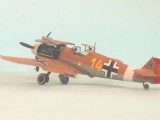
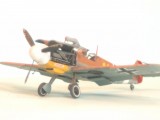
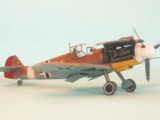
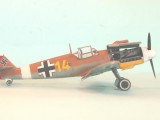
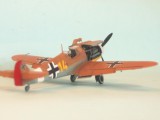
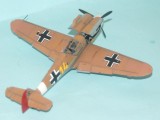
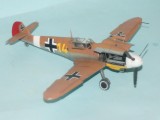
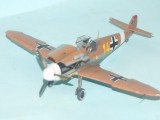
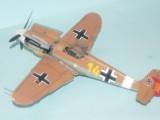
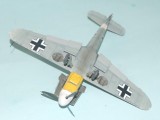

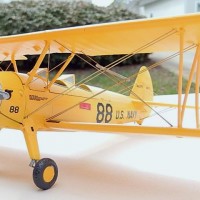
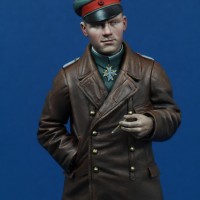
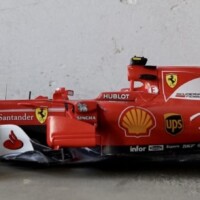
Nice build and great paint for this ace's plane ! congratuations !
Good looking 109 Tom & as usual a good historical reference to go with it.
Just got this kit & I don't mind "fiddly" just glad to hear it is a good one.
"...When I get my “intermittent internet connectivity” problems sorted Thursday, I will upload the revised photos which show this better..." -
Apparently this problem is still an issue...or is it?
Great narration and a greater looking model, excellent work, Tom!
hell of a pilot
Tom,
Quite a story to go with your great model. Nice to hear that a rather new kit maker is at the top for this particular 109 version and scale. Thanks!
Hi Tom. Thanks for the history of the plane and pilot. As I have come to assume with you, your model looks great as well!
Just picked up that kit as well, and while I have a Century 21 1/32 109F destined for Marseille's markings, doing the in 1/48 is also an option...hmmm
Great article as always Tom.
I bought this kit for around sixteen dollars U.S. add shipping charges and it still is a very reasonable kit with lots of details and several propeller options and separate radiator flaps etc,etc. Really it is a steal. The boxing is different ... I thought it was a closed ended flimsy box like some of the earlier ICM Spitfire boxing's however, they inserted a cardboard box that opens from the top inside the original box. My kit sprues were not rapped in clear plastic bags, the canopies were put into a zip lock bag and the rest was held firmly by the box. The scratches were few if at all. Interesting approach, Also, the kit lacks the customary rivets which is refreshing to see in this scale.
Two thumbs up on the build and of course the writing is of interest and inspiration for those who want to model this kit..
A nice build and an interesting read as always! He sounds like he was one hell of a pilot!
Nice Tom, as usual a great interesting story to go with it.
Well done Tom.
Great job. 🙂
Nice work, Tom. When these Fs first appeared from Zvezda they were considered the best on the market in the scale. This is still the case, in my view.
Tom,
Great model and a very good read on Marseille. I like what you have done with this kit.